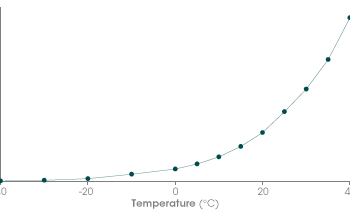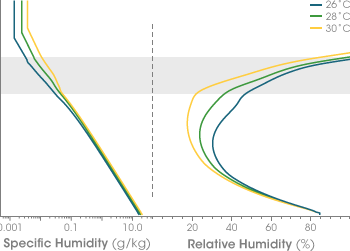

It’s not the Heat, it’s the Humidity |
|||
The abundance of water vapor in the atmosphere is usually expressed as “relative humidity”: the percent of water in the air relative to the amount of water the air can hold. Just as an 8-ounce cup holding 4 ounces of water is 50 percent full, air that contains half the water it can hold is said to be at 50 percent relative humidity. But if you pour the 4 ounces of water into a 16-ounce cup, the cup is only 25 percent full, even though you still have the same amount of water. The same principle applies to the percentage of water in the atmosphere. As temperatures increase, the air becomes capable of holding more water, and the percent of water in the air drops unless more water is added. |
|||
 |

In climate modeling, scientists have assumed that the relative humidity of the atmosphere will stay the same regardless of how the climate changes. In other words, they assume that even though air will be able to hold more moisture as the temperature goes up, proportionally more water vapor will be evaporated from the ocean surface and carried through the atmosphere so that the percentage of water in the air remains constant. Climate models that assume that future relative humidity will remain constant predict greater increases in the Earth’s temperature in response to increased carbon dioxide than models that allow relative humidity to change. The constant-relative-humidity assumption places extra water in the equation, which increases the heating. Many have questioned whether this prediction of a wetter future atmosphere is right, including Dessler and Minschwaner. “There’s no theoretical, simple line of reasoning that should say that it [relative humidity] should be constant,” says Ian Folkins, an associate professor of atmospheric sciences at Dalhousie University in Halifax, Nova Scotia, Canada. Critics of the constant-relative-humidity assumption have said that compensating effects will prevent large quantities of extra water from entering the atmosphere, explains Dessler. “The atmosphere is very efficient at generating dry air. Increases in these processes could balance increased evaporation in a warmer climate, leading to little change in the humidity in the atmosphere.” Like air running over the cooling coils in an air conditioner, he adds, air that rises to high altitudes cools off and water condenses out, leaving the air drier. Water Woes: Predicting the Humidity of the FutureTo start to pin down the relationship between humidity and temperature, Minschwaner and Dessler modeled how water in the atmosphere around 11 to 14 kilometers from the surface of the Earth reacts to changes in temperature. They chose to focus their study on the upper troposphere over the tropics because it is a physically simple system compared to other sections of the atmosphere. For example, “things like evaporation of rain don’t have much of an effect,” Dessler says. While there is very little water in this section of the upper atmosphere, the climate is quite sensitive to the amount of water that is there because, closer to the cold of space, water cools off and becomes far more reluctant to let go of any heat it absorbs. The higher the altitude, the more efficiently water vapor traps heat. Minschwaner and Dessler’s model describes how the humidity of the upper troposphere changes as the surface warms. As the Earth warms, more water is expected to evaporate from the surface. At the same time, thunder storms are expected to become more severe and extend to higher altitudes in the atmosphere. Since temperature decreases with altitude, warm, humid air rising to higher altitudes in such storms will encounter colder temperatures, and therefore more water is ’freeze dried’ out.” These two factors oppose each other, and the overall change in water vapor in the upper troposphere is a combination of these opposing forces. In order to predict changes in humidity, you have to predict both increased evaporation from warmer temperatures and increased freeze-drying from convection to higher altitudes. Minschwaner and Dessler’s model shows that these two factors are closely coupled, and in fact, the two can not vary independently. |
As air warms it becomes capable of holding more and more water vapor. This graph shows the maximum amount of water in air at temperatures ranging from -40 to 40 degrees Celsius. (Graph courtesy Quantitative Environmental Learning Project) |
|
 |

Within these constraints, the model does predict that there will be a net increase in the water content of the upper troposphere as the Earth’s surface temperature rises, but not so much that the relative humidity remains constant. That means that water vapor will cause the Earth to warm, because the feedback is positive, but it won’t warm as much as it would if constant relative humidity were maintained—a result that contradicts the assumptions put into big global climate models. “I don’t think too many people would have expected a simple model like this to give a result other than the one that people have been assuming will happen,” Sherwood notes. |
Minschwaner & Dessler’s model results showed an increase in water vapor in the upper troposphere (grey) as temperatures rose (left), but not rapidly enough to maintain constant relative humidity (right). Therefore, their model predicts increasing temperatures to increase humidity, but not to the degree assumed by many climate models. The blue, green, and yellow lines represent progressively increasing temperatures. (Graph adapted from Minschwaner & Dessler) |
|